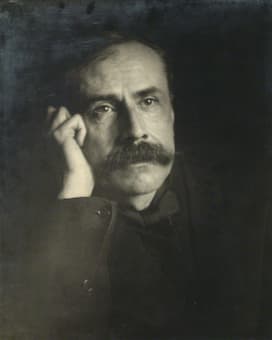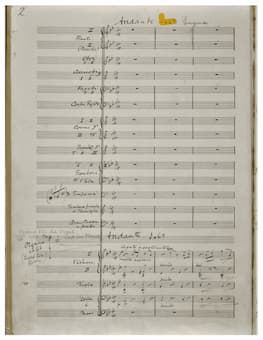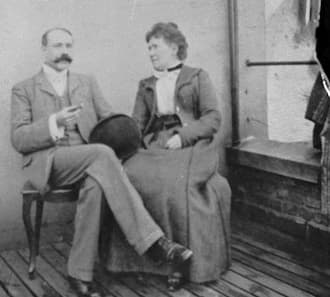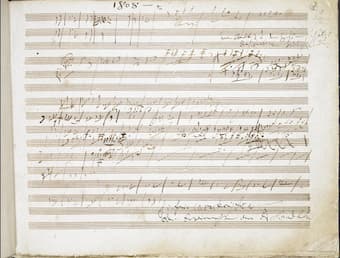
Edward Elgar
One October evening in 1898, having returned home after a long day teaching, Edward Elgar lit a cigar and began to improvise at the piano. Elgar recalls, “I began to play, and suddenly my wife interrupted by saying: ‘Edward, that’s a good tune.’ I awoke from the dream. ‘Eh! Tune, what tune!’ And she said, ‘Play it again, I like that tune.’ I played and strummed, and played, then she exclaimed: ‘That’s the tune.’ The voice of [my wife] asked with a sound of approval, ‘What is that?’ I answered, ‘Nothing – but something might be made of it.’” The emerging Enigma Variations, according to Elgar, “commenced in a spirit of humor & continued in deep seriousness, and contains sketches of the composer’s friends. It may be understood that these personages comment or reflect on the original theme & each one attempts a solution of the Enigma, for so the theme is called. The sketches are not portraits but each variation contains a distinct idea founded on some particular personality or perhaps on some incident known only to two people. This is the basis of the composition, but the work may be listened to as a piece of music apart from any extraneous consideration.”
Edward Elgar: Variations on an Original Theme (Enigma), Op. 36 – Introduction (Academy of St. Martin in the Fields Orchestra; Neville Marriner, cond.)
Edward Elgar: Variations on an Original Theme (Enigma), Op. 36 – Variation 1: C. A. E. (The Composer’s Wife) (Academy of St. Martin in the Fields Orchestra; Neville Marriner, cond.)
Edward Elgar: Variations on an Original Theme (Enigma), Op. 36 – Variation 4: W. M. B. (William Meath Baker) (Academy of St. Martin in the Fields Orchestra; Neville Marriner, cond.)

Theme of Elgar’s Enigma Variations
The music essentially presents two mysteries; first the identities of his friends, with each person save one identified by initials or by a nickname. As for the other mystery, Elgar wrote, “The enigma I will not explain—its dark saying must be left un-guessed, and I warn you that the apparent connection between the Variations and the Theme is often of the slightest texture; further, through and over the whole set another and larger theme ‘goes,’ but is not played—so the principal Theme never appears…” The piece was finished on 18 February 1899 and published by Novello & Co. It was first performed at St James’s Hall in London on 19 June 1899, conducted by Hans Richter. Critics were at first irritated by the layer of mystification, but most praised the substance, structure, and orchestration of the work. Elgar later revised the final variation, adding 96 new bars and an organ part. Today, you are most likely to hear this new version, which first sounded at the Worcester Three Choirs Festival on 13 September 1899 with Elgar conducting.
Edward Elgar: Variations on an Original Theme (Enigma), Op. 36 – Variation 5: R. P. A. (Richard Penrose Arnold) (Academy of St. Martin in the Fields Orchestra; Neville Marriner, cond.)
Edward Elgar: Variations on an Original Theme (Enigma), Op. 36 – Variation 8: W. N. (Winifred Norbury) (Academy of St. Martin in the Fields Orchestra; Neville Marriner, cond.)
Edward Elgar: Variations on an Original Theme (Enigma), Op. 36 – Variation 9: Nimrod (A. J. Jaeger) (Academy of St. Martin in the Fields Orchestra; Neville Marriner, cond.)
The theme is of simple three-part design, and dips between G minor and G major. Elgar wrote of this theme, “it expressed my sense of the loneliness of the artist as described in the first lines of Arthur O’Shaughnessy’s ode The Music Maker.”
We are the music makers,
And we are the dreamers of dreams,
Wandering by lone sea-breakers,
And sitting by desolate streams; —
World-losers and world-forsakers,
On whom the pale moon gleams:
Yet we are the movers and shakers
Of the world forever, it seems.

Edward and Alice Elgar
Variation I (C.A.E.) represents Alice Elgar. It is a prolongation of the theme with delicate romantic undertones. Variation II (H.D.S-P.) identifies Hew David Steuart-Powell, a pianist with whom Elgar played chamber music. Variation III (R.B.T.) references Richard Baxter Townshend, a classics scholar at Oxford who rode through that town on his bicycle, the bell constantly ringing. Variation IV (W.M.B.) identifies William Meath Baker, a country squire, gentleman and scholar, while Variation V (R.P.A.) recognizes Richard Penrose Arnold, “a great lover of music which he played (on the pianoforte) in a self-taught manner, evading difficulties but suggesting in a mysterious way the real feeling.”
Edward Elgar: Variations on an Original Theme (Enigma), Op. 36 – Variation 10: Intermezzo: Dorabella (Dora Penny) (Academy of St. Martin in the Fields Orchestra; Neville Marriner, cond.)
Edward Elgar: Variations on an Original Theme (Enigma), Op. 36 – Variation 13: Romanza: *** (Lady Mary Lygon) (Academy of St. Martin in the Fields Orchestra; Neville Marriner, cond.)
Edward Elgar: Variations on an Original Theme (Enigma), Op. 36 – Variation 14: Finale: E. D. U. (The Composer) (Academy of St. Martin in the Fields Orchestra; Neville Marriner, cond.)

Manuscript of Elgar’s Enigma Variations
Variation VI (Ysobel) represents Isabel Fitton, a woman of “grave, statuesque beauty,” while Variation VII (Troyte) pictures Arthur Troyte Griffith, an architect and one of Elgar’s most intimate friends. Variation VIII (W.N.) is named for Winifred Norbury, but actually is the portrait of the manor house “Sherridge,” where she lived. Variation IX (Nimrod) is August Jaeger, who greatly furthered Elgar’s career, and Variation X (Dorabella) identifies the cheerful and music-loving Dora Penny, whose stutter is gently parodied in the woodwinds. Variation XI (G.R.S.) belongs to George Robertson Sinclair, the energetic organist of Hereford Cathedral. Elgar later explained “this variation has nothing to do with organs or cathedrals, as the first few bars were suggested by his great bulldog, Dan falling down the steep ban into the River Wye; his paddling upstream to find a landing place; and his rejoicing bark on landing.” Variation XII (B.G.N.) belongs to the accomplished amateur cellist Basil Nevinson, who played chamber music with Elgar. In Variation XIII (***Romanza) the asterisks in place of initials suggest further mystery, and Variation XIV (Finale: E.D.U.) is Elgar’s nickname given to him by his wife Alice. At the end of the score, Elgar inscribed a slightly altered quote from Torquato Tasso’s Jerusalem Delivered. “I long for much, I hope for little, I ask nothing.” And by the way, the word “Enigma,” serving as the title for the theme of the Variations was added to the score at a later stage.
For more of the best in classical music, sign up to our E-Newsletter
Edwar Elgar: Variations on an Original Theme (Enigma) Op. 36
